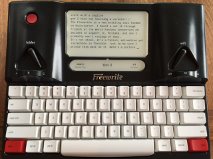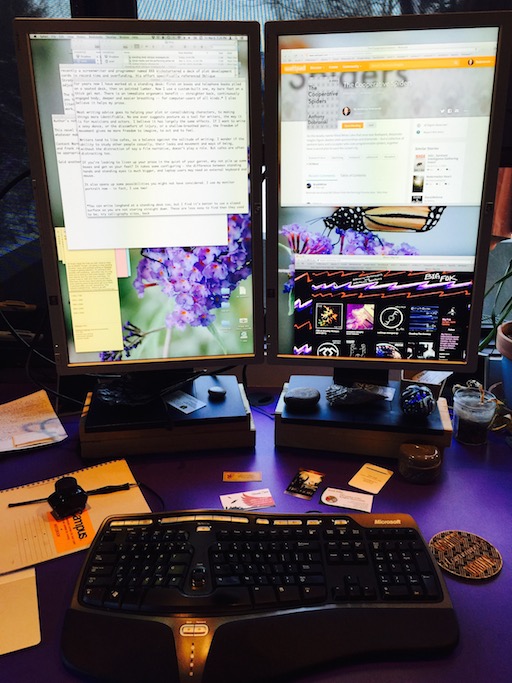Less tool than fetish, and disappointing.
Funded on Kickstarter, the new Freewrite is a solid, lovingly-crafted device that promises to return writers to a place of distraction-free spontaneity. From its low-power e-ink screen to the aluminum case – with handle – to the deep-traveling satisfyingly-clicky Cherry keys, the Freewrite consciously recalls early computers, manual typewriters, and a more physical, engaged time. I love touching it. Really.

Alas, none of those keys moves the cursor.
“Distraction-free” writing is not a method like touch-typing, but an ideal. For some, it means paper. For others (like me), it means starting my work in a text editor, not a print-oriented word processor like Word or OpenOffice. For still others, it means gimmicky apps that literally delete your writing if you pause too long. Whatever works, right? And if it doesn’t work, you can do something else.
Not on the Freewrite. For the Freewrite, “distraction-free” means, and only means, a weirdly oppressive no-turning-back mentality, like Allen Ginsberg’s “first thought best thought” warped from liberating ideal into blind diktat without recourse.
You can only keep keying. You can’t go backwards, save to delete – and that has the acceleration of a Tesla, one word, two words, a paragraph whoa! You can’t go up three lines and add a header. You must go forward, only forward, like Orpheus leaving Hades.
I don’t even write that way on paper.
The Freewrite also requires a better computer to finish one’s work. Just getting text out of it – set up a special account, to either e-mail the work as an non-editable PDF, or to push it into Dropbox folders as Word .docx files – is a ridiculous kluge, a giant chicken-wire afterthought that makes the whole Freewrite process feel like something out of the movie Brazil. (more…)
Tag: ergonomics
-
Twenty lousy minutes on the Freewrite (review)
-
Posture for writers (standing desks)
For a decade now, I have worked at a standing desk: first on boxes and books piled on a seated desk, then on hasty constructs made from scrap lumber. Now I stand at a custom-built desk, my bare feet on a thick gel mat. There is an obvious and immediate ergonomic benefit for any computer user* — straighter back, continuously engaged body, deeper and easier breathing. I also believe it helps my prose.
Most writing advice goes to helping your plot or consolidating characters, to making things more identifiable. No one ever suggests posture as a tool for writers, the way it is for musicians and actors, so, let me.
Writers play a lot of roles in their heads, and it helps to stand while acting them out. If I want to write a sexy dance, or the discomfort of injury, or a shallow-breathed panic, the freedom of movement gives me more freedom to imagine, to act and to feel.
Writers tend to like cafes, as a balance against the solitude of writing. I wonder if the ability to study other people casually, their looks and movement and ways of being, without the distraction of, say, a film narrative, doesn’t play a role. But cafes are often distracting too.
If you’re looking to liven up your prose in the productive quiet of your garret, why not pile up some boxes and get on your feet? It takes a few minutes to measure your own ideal heights, and possibly some configuring – the distance between hands and eyes is greater standing than seated, so laptop users may need an external keyboard and mouse.
It also opens up some possibilities you might not have considered. I use my monitor portrait now – in fact, I use two!

Of course, you can still sit down from time to time. I don’t stand to pay bills.
*You can write longhand at a standing desk too, but I find it’s better to use a sloped surface so you are not staring straight down. These are less easy to find than they used to be. Search “writing slant” or “writing slope,” or try back sites, calligraphy sites, and of course auction sites.